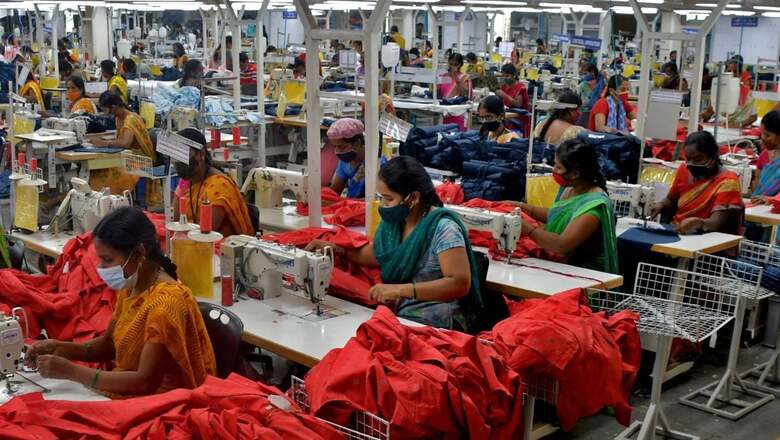
views
India is gearing up for the ambitious ‘Bharat Tex’ expo from February 26 to 29. As the world’s largest textiles event, Bharat Tex will have more than 3,500 exhibitors and over 3,000 overseas participant buyers. Over 40,000 visitors from more than 40 countries are expected to attend. The mega event will provide a unique opportunity to India to showcase itself as a global textile sourcing and investment destination. Union Minister for Textiles Piyush Goyal held a review meeting on Wednesday to take stock of the preparations underway for Bharat Tex, and said the expo will contribute significantly to the growth of textile sector in India.
The Union Minister also shared his vision and new ideas for branding and promoting Bharat Tex 2024 and said that the event should be widely inclusive. He recommended that an online directory of all participating exhibitors be prepared which will become the encyclopedia of all textile players. The event is being organized by 11 textile export promotion councils (EPCs) and is supported by the Ministry of Textiles. The bulk of the focus throughout the expo will be on projecting India as a nation that can fulfil the world’s textile needs.
According to Rachna Shah, Secretary in the Ministry of Textiles, the expo is expected to bring together stakeholders from across the textile value chain, including government and industry representatives.
India’s textile industry is interested in participating in the event. Several successful roadshows and investor roundtables have been conducted in India and globally and multiple rounds of interactions have been successfully concluded with Foreign Embassies in India and Indian Missions Abroad for evincing international interest and participation in the event. Uttar Pradesh is participating in Bharat Tex as the Partner State and Madhya Pradesh as the Focus State.
Several heavyweights from the industry have joined hands to make the expo a resounding success. Aditya Birla Group and Reliance Industries Ltd. are participating as Platinum and Gold partners, respectively, while Arvind Ltd., Indorama Ventures, Trident Group, and Welspun are partnering as Silver partners. At the same time, Chargeurs PCC (France), Shahi Exports, Pearl Global and WGSN have been announced as Associate Partner, Sustainability Partner, Fashion Partner and Trend Partner, respectively.
HOW IS INDIA’S TEXTILE INDUSTRY FARING?
All is not well in India’s textiles sector. The industry is going through a tough phase, primarily due to the influx of Chinese goods that are cheap and create a disadvantageous climate for Indian manufacturers. Valued at over $150 billion, India’s textile industry is taking a hit as China dumps its man-made fibre (MMF) fabrics in India at relatively lower prices. Importantly, the textile sector is the second largest employer after agriculture, with 45 million people directly working in the sector and another 100 million depending on it from allied sectors. Wages for the people working in the sector are falling, forcing many to look at alternative employment opportunities.
The festive season from October to December last year remained largely tepid for the textile industry. Exports witnessed a downward trend in November, with readymade garments alone experiencing a 15% decline. However, exports of cotton yarn and handloom products swam against the current, recording a commendable 6% increase in November last year.
For readymade garments, export figures dropped from $10.36 billion in April-November 2022 to $8.84 billion in the corresponding months of 2023. Similarly, exports of jute and associated products sank to $234 million in April-November 2023 from $303 million in the corresponding period of 2022. Export of handicrafts items dropped 10% to $1.04 billion from $1.16 billion in April-November 2022.
The global geopolitical climate, marred by wars in West Asia and Ukraine, is also a major contributing factor behind the industry’s recent troubles.
Industry players are hopeful of the situation taking a turn for the better in the coming weeks and months, as the onset of summer pushes demand for cotton clothing across the Northern Hemisphere. According to the Indian Brand Equity Foundation (IBEF), India is one of the largest consumers and producers of cotton. It has the world’s highest cotton acreage of about 13.5 million hectares, which is 38% of the global area under cotton cultivation.
TURNING THE FORTUNES OF THE TEXTILE INDUSTRY AROUND
Needless to say, the textile industry’s concerns are being looked into. Despite considerable challenges, the market for Indian textiles and apparel manufacturers is expected to double by 2030. According to a report by FICCI-Wazir Advisors, the textile market size is projected to grow at a 10% CAGR to reach $350 billion by 2030. The IEBF report is a bit more promising, as it pegs the CAGR of the textile and apparel market at close to 15%. It also estimates that the textile market size will grow to $387.3 billion by 2028.
To further aid the textile industry, the Ministry is working towards establishing a ‘Centre of Sustainable Fashion Technology’, which will promote capacity building and research in sustainability. At the same time, the findings and recommendations of the INDIAsize initiative have been finalised and are set to be implemented soon. INDIAsize initiative was carried out to develop standard body sizes for Indian apparel sector to address the prevailing disparities and inconsistencies in provided fits. This will pave the way for the Indian industry to work on making standard sizes tailored to suit the Indian body types.
Meanwhile, the Modi government’s PLI scheme for the textile sector is expected to bring in fresh investment of more than Rs 19,000 crore over the next five years, helping it achieve a cumulative turnover of over Rs 3 lakh crore and creating about 7.5 lakh direct employment opportunities.
Bharat Tex is seen as the government’s big move to revitalise the Indian textile industry, and push it towards doubling its contribution to the national GDP to 5% by 2030. Getting more countries to import textiles from India will be a prime focus during the mega expo next month, as India looks to overcome the challenges faced by the industry by ensuring more international exposure for it. At the same time, there is also a need for investing in newer technologies and filling the various gaps, which exist in the textile value chain. Since the sector is dominated by micro, small and medium enterprises (MSMEs), there is an urgent need to fix the supply chain loopholes that arise out of fragmentation and lack of coordination among stakeholders. Only then will India emerge as the biggest textile manufacturing hub of the world in the years to come.
Views expressed in the above piece are personal and solely those of the author. They do not necessarily reflect News18’s views.

















Comments
0 comment